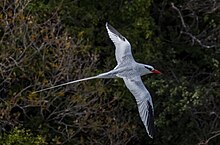Phaethontiformes
| Phaethontiformes | |
|---|---|

| |
| Phaethon aethereus | |
| Klasifikasi ilmiah | |
| Kerajaan: | |
| Filum: | |
| Kelas: | |
| Ordo: | Phaethontiformes Sharpe, 1891
|
| Famili | |
| |
Phaethontiformes /ˌfeɪ.ɪˈθɒntɪfɔːrmiːz/ adalah sebuah ordo burung yang berisi satu famili yang masih ada yakni Buntut sate (Phaethontidae), dan satu famili yang sudah punah dari zaman kenozoikum awal yakni Prophaethontidae. Beberapa genera fosilnya telah dideskripsikan.
Sejarah Taksonomi
suntingSecara tradisional, buntut sate (phaethontidae) dikelompokkan dalam ordo Pelecaniformes, yang terdiri dari burung pelikan, pecuk, Anhingidae, Sulidae, dan Cikalang. Dalam taksonomi Sibley-Ahlquist Pelecaniformes disatukan dengan ordo lain menjadi Ciconiiformes yang lebih besar. Baru-baru ini pengelompokan tersebut telah ditemukan secara masif parafili (kerabat dekat yang hilang dari kelompok yang jauh terkait) dan terpecah lagi.
Analisis mikroskopis struktur cangkang telur oleh Konstantin Mikhailov pada tahun 1995 menemukan bahwa cangkang telur buntut sate tidak memiliki penutup bahan mikroglobular tebal dari anggota Pelecaniformes lainnya.[1]
Beberapa studi awal dalam dekade terakhir menyarankan Phaethontiformes berkerabat jauh dengan Procellariiformes,[2][3] tetapi sejak 2004 mereka telah ditempatkan dalam klad Metaves, atau dalam garis keturunan yang tidak memiliki kedekatan dengan Procellariiformes berdasarkan hasil studi molekuler terbaru.[4][5][6][7]
Dalam makalah yang dibuat oleh Jarvis, et al. 2014 yang berjudul Whole-genome analyses resolve early branches in the tree of life of modern birds menyelaraskan Phaethontiformes paling dekat dengan burung sunbittern (Eurypygidae) dan Kagu dari ordo Eurypygiformes, dengan dua klad tersebut membentuk kelompok saudara dari "burung air inti", hipotesis Aequornithes, dan Metaves ditinggalkan.[8]
Referensi
sunting- ^ Mikhailov, Konstantin E. (1995). "Eggshell structure in the shoebill and pelecaniform birds: comparison with hamerkop, herons, ibises and storks". Canadian Journal of Zoology. 73 (9): 1754–70. doi:10.1139/z95-207.
- ^ Mayr, G (2003). "The phylogenetic affinities of the Shoebill (Balaeniceps rex)". Journal für Ornithologie. 144 (2): 157–175. doi:10.1007/bf02465644.
- ^ Bourdon, E.; et al. (2005). "Earliest African neornithine bird: A new species of Prophaethontidae (Aves) from the Paleocene of Morocco". J. Vertebr. Paleontol. 25 (1): 157–170. doi:10.1671/0272-4634(2005)025[0157:eanban]2.0.co;2.
- ^ Fain, M.G.; Houde, P. (2004). "Parallel radiations in the primary clades of birds". Evolution. 58 (11): 2558–73. doi:10.1554/04-235. PMID 15612298.
- ^ Ericson, G.P.; et al. (2006). "Diversification of Neoaves: integration of molecular sequence data and fossils". Biol. Lett. 2 (4): 543–547. doi:10.1098/rsbl.2006.0523. PMC 1834003 . PMID 17148284.
- ^ Hackett, S.; et al. (2008). "A Phylogenomic Study of Birds Reveals Their Evolutionary History". Science. 320 (5884): 1763–1768. Bibcode:2008Sci...320.1763H. doi:10.1126/science.1157704. PMID 18583609.
- ^ Naish, D. (2012). "Birds." Pp. 379-423 in Brett-Surman, M.K., Holtz, T.R., and Farlow, J. O. (eds.), The Complete Dinosaur (Second Edition). Indiana University Press (Bloomington & Indianapolis).
- ^ Jarvis, Erich D.; et al. (2014). "Whole-genome analyses resolve early branches in the tree of life of modern birds". Science. 346 (6215): 1320–1331. Bibcode:2014Sci...346.1320J. doi:10.1126/science.1253451. PMC 4405904 . PMID 25504713.